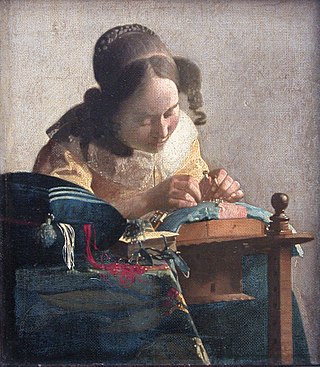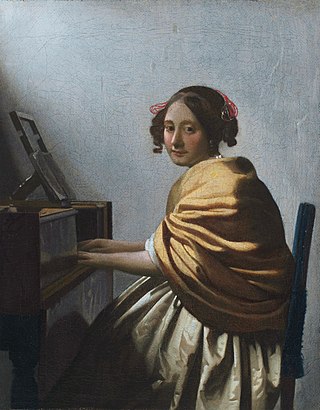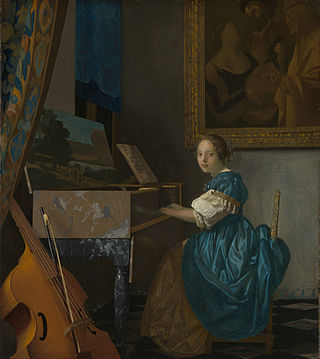
Johannes Vermeer was a Dutch painter who specialized in domestic interior scenes of middle-class life. He is considered one of the greatest painters of the Dutch Golden Age. During his lifetime, he was a moderately successful provincial genre painter, recognized in Delft and The Hague. He produced relatively few paintings, primarily earning his living as an art dealer. He was not wealthy; at his death, his wife was left in debt.

The Little Street is a painting by the Dutch painter Johannes Vermeer, executed c. 1657–1658. It is exhibited at the Rijksmuseum of Amsterdam, and signed, below the window in the lower left-hand corner, "I V MEER".

The Milkmaid, sometimes called The Kitchen Maid, is an oil-on-canvas painting of a "milkmaid", in fact, a domestic kitchen maid, by the Dutch artist Johannes Vermeer. It is in the Rijksmuseum in Amsterdam, the Netherlands, which regards it as "unquestionably one of the museum's finest attractions".

Christ in the House of Martha and Mary is an oil painting finished in 1655 by the Dutch Golden Age painter Johannes Vermeer. It is now in the Scottish National Gallery in Edinburgh. It is the largest painting by Vermeer and one of the very few with an overt religious subject. The story of Christ visiting the household of the two sisters Mary of Bethany and Martha goes back to the New Testament. The work has also been called Christ in the House of Mary and Martha.

The Lacemaker is a painting by the Dutch artist Johannes Vermeer (1632–1675), completed around 1669–1670 and held in the Louvre, Paris. The work shows a young woman wearing a yellow bodice, holding up a pair of bobbins in her left hand as she carefully places a pin in the pillow on which she is making her bobbin lace.

Young Woman Seated at a Virginal or A Young Woman Seated at a Virginal are alternate titles for two different works of art, neither of which is a copy of the other, both by Johannes Vermeer:

A Young Woman Seated at the Virginals is a painting by Johannes Vermeer, though this was for a long time widely questioned. A series of technical examinations from 1993 onwards confirm the attribution. It is thought to date from c.1670 and is now in part of the Leiden Collection in New York. It should not be confused with Young Woman Seated at a Virginal in the National Gallery, London, also by Vermeer.

Lady Seated at a Virginal, also known as Young Woman Seated at a Virginal, is a genre painting created by the Dutch Golden Age painter Johannes Vermeer in about 1670–1672 and now in the National Gallery, London.

Lady Standing at a Virginal is a genre painting created by the Dutch artist Johannes Vermeer in about 1670–1672, now in the National Gallery, London.

Officer and Laughing Girl, also known as Officer and a Laughing Girl, Officer With a Laughing Girl or, in Dutch, De Soldaat en het Lachende Meisje, is an oil painting on canvas executed ca. 1657 by the Dutch artist Johannes Vermeer. Its dimensions are 50.5 by 46 cm. It is now one of three pictures by Vermeer in The Frick Collection in New York.

Girl with a Red Hat is a rather small painting, signed by the Dutch painter Johannes Vermeer. It is seen as one of a number of Vermeer's tronies – depictions of models fancifully dressed that were not intended to be portraits of specific, identifiable subjects. Whether Vermeer chose family members as models or found them elsewhere in Delft is irrelevant to the appreciation of his paintings. Its attribution to Vermeer – as it is on a (recycled) wood panel and not on canvas – has been a matter of controversy with scholars on both sides of the argument. However, in recent study carried out by the curators of National Gallery of Art certainty has been established on the authorship of the painting by Vermeer, a conclusion also supported by Dutch experts.

View of Delft is an oil painting by Johannes Vermeer, painted c. 1659–1661. The painting of the Dutch artist's hometown is among his best known. It is one of three known paintings of Delft by Vermeer, along with The Little Street and the lost painting House Standing in Delft, and his only cityscape. According to art historian Emma Barker, cityscapes across water, which were popular in the Netherlands at the time, celebrated the city and its trade. Vermeer's View of Delft has been held in the Dutch Royal Cabinet of Paintings at the Mauritshuis in The Hague since its establishment in 1822.

Woman Holding a Balance, also called Woman Testing a Balance, is an oil painting by Dutch Golden Age painter Johannes Vermeer, now in the National Gallery of Art in Washington, DC.

Girl Reading a Letter at an Open Window, also known as Lady reading at an open window, is an oil painting by Dutch Golden Age painter Johannes Vermeer. Completed in approximately 1657–1659, the painting is on display at the Gemäldegalerie in Dresden, which has held it since 1742. For many years, the attribution of the painting—which features a young Dutch woman reading a letter before an open window—was lost, with first Rembrandt and then Pieter de Hooch being credited for the work before it was properly identified in 1880. After World War II, the painting was briefly in possession of the Soviet Union. In 2017, tests revealed that the painting had been altered after the painter's death.

The Procuress is a 1656 oil-on-canvas painting by the then 24-year-old Johannes Vermeer. It can be seen in the Gemäldegalerie Alte Meister in Dresden. It is his first genre painting and shows a scene of contemporary life, an image of mercenary love perhaps in a brothel. It differs from his earlier biblical and mythological scenes. It is one of only three paintings Vermeer signed and dated. In 1696 the painting, being sold on an auction in Amsterdam, was named "A merry company in a room".
Jacob Abrahamsz. Dissius was a Dutch typographer and printer. He inherited a collection of 21 of Johannes Vermeer's works, including The Milkmaid, Portrait of a Young Woman, A Girl Asleep, Woman Holding a Balance, and The Music Lesson. In 1680, he married Magdalena, daughter and sole heir of Vermeer's main patron Maria de Knuijt, her mother, with her father Pieter van Ruijven. Dissius died in 1695, and his collection was auctioned off in Amsterdam the following year.

The Guitar Player is an oil painting by Dutch Golden Age artist Johannes Vermeer (1632–1675), dated c. 1672. This work of art is one of Vermeer's final artistic activities, providing insight into the techniques he mastered and approaches to painting he favored. The painting has been on display at Kenwood House, London since the 1920s, as part of the Iveagh Bequest collection. After being recovered from a theft in 1974, when the painting was held for ransom, The Guitar Player was returned to Kenwood House.

Tim's Vermeer is a 2013 documentary film, directed by Teller, produced by his stage partner Penn Jillette and Farley Ziegler, about inventor Tim Jenison's efforts to duplicate the painting techniques of Johannes Vermeer, in order to test his hypothesis that Vermeer painted with the help of optical devices.

Cardplayers in a Sunlit Room (1658) is an oil-on-canvas painting by the Dutch painter Pieter de Hooch; it is an example of Dutch Golden Age painting and is now in the Royal Collection, and on display at the King's Gallery in London.

Johannes Vermeer was a Dutch Baroque Period painter who specialized in domestic interior scenes of middle class life. His works have been a common theme in literature and films in popular culture since the rediscovery of his works by 20th century art scholars.

















